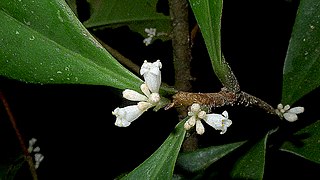
The Santalales are an order of flowering plants with a cosmopolitan distribution, but heavily concentrated in tropical and subtropical regions. It derives its name from its type genus Santalum (sandalwood). Mistletoe is the common name for a number of parasitic plants within the order.

The Portulacaceae are a family of flowering plants, comprising 115 species in a single genus Portulaca. Formerly some 20 genera with about 500 species, were placed there, but it is now restricted to encompass only one genus, the other genera being placed elsewhere. The family has been recognised by most taxonomists, and is also known as the purslane family. It has a cosmopolitan distribution, with the highest diversity in semiarid regions of the Southern Hemisphere in Africa, Australia, and South America, but with a few species also extending north into Arctic regions. The family is very similar to the Caryophyllaceae, differing in the calyx, which has only two sepals.

Plumeria, known as frangipani, is a genus of flowering plants in the family Apocynaceae. Most species are deciduous shrubs or small trees. The species variously are endemic to Mexico, Central America, and the Caribbean, and as far south as Brazil and north as Florida, but are grown as cosmopolitan ornamentals in warm regions. Common names for plants in the genus vary widely according to region, variety, and whim, but frangipani or variations on that theme are the most common. Plumeria is also used as a common name, especially in horticultural circles.

Cissus is a genus of approximately 350 species of lianas in the grape family (Vitaceae). They have a cosmopolitan distribution, though the majority are to be found in the tropics.

Chrysochlamys is a plant genus of the family Clusiaceae.

Arenaria is a genus of flowering plants, within the family Caryophyllaceae.

Calyptranthes is a genus of flowering plants in the family Myrtaceae. They are known commonly as lidflowers, spicewoods, and mountainbays. There are about 100 species.

Olacaceae is a family of flowering plants in the order Santalales. They are woody plants, native throughout the tropical regions of the world. As of July 2021, the circumscription of the family varies; some sources maintain a broad family, others split it into seven segregate families.

Schoepfiaceae is a family of flowering plants recognized in the APG III system of 2009. The family was previously only recognized by few taxonomists; the plants in question usually being assigned to family Olacaceae and Santalaceae.

Picramnia, the bitterbushes, is a genus of plant considered to be in the family Picramniaceae, but sometimes placed in Simaroubaceae. The name is conserved against the genera Pseudo-brasiliumAdans., and TaririAubl., both which have been rejected.

Schoepfia arenaria is an extremely rare species of hemiparasitic flowering plant in the Schoepfiaceae family. It grows as a small, multi-trunked tree. It is endemic to Puerto Rico, where it is found growing along the northern coast. A local Spanish vernacular name recorded for this tree is araña ('spider'). It has no common name in English.
Schoepfia harrisii is a species of flowering plant in the Schoepfiaceae family. It is a small tree or shrub, growing two to five metres tall. It is endemic to Jamaica, where it is only known to occur in the parishes of Trelawny and Clarendon, in what is known as Cockpit Country, a region of many steep, rounded, limestone hills, shaped like an egg-carton. Here it grows on crags in moist woodland, between 600 and 900m in elevation.
Schoepfia multiflora is a species of flowering plant in the Schoepfiaceae family. It is a smallish tree, growing six to eight metres tall, exceptionally to ten metres. It is endemic to Jamaica, where it grows on rocky limestone in the woodlands of the central region.

Castela is a genus of thorny shrubs and small trees in the family Simaroubaceae. Members of the genus are native to the Americas, especially the tropical regions. The generic name honours the French naturalist René Richard Louis Castel. Castela is dioecious, with male and female flowers on separate plants.

Daphnopsis is a plant genus in the family Thymelaeaceae. There are 50 to 65 species distributed in the Neotropics. They are shrubs and small trees with tubular or bell-shaped flowers. Individuals are dioecious, with male and female flowers produced on separate trees.

Connarus is a genus of plants in the family Connaraceae.
Elaeagia is a genus of flowering plants in the family Rubiaceae. The genus is found from Mexico to tropical America.

Quinchamalium is a genus of flowering plant in the family Schoepfiaceae, with a single species Quinchamalium chilense, native to Chile, Argentina, Peru and Bolivia. Depending on the latitude, it can be found from sea level to 3,800 m in altitude.

Mitracarpus is a plant genus in the coffee family Rubiaceae. Girdlepod is a common name for some species in this genus.

Tetrapterys is a genus of flowering plants in the family Malpighiaceae, native to Latin America and the Caribbean, from Mexico through to Argentina, but excluding Chile. Small trees, shrubs or vines, they are known to be toxic to livestock if consumed for long periods of time, and T. mucronata and T. styloptera have hallucinogenic effects in humans similar to ayahuasca.


















